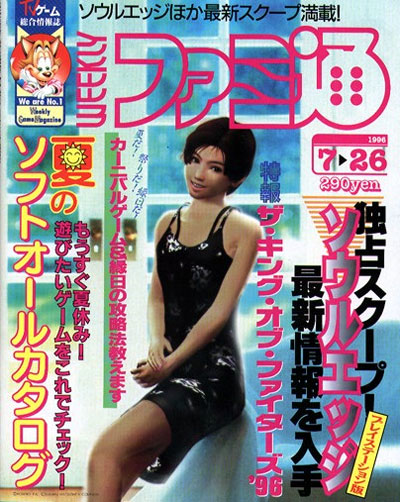Reprise of the Robo-Girls: A Brief History of Virtual Idols

Virtual idols have been around longer than you think — shown above is a magazine cover featuring Kyoko Date from 1996. In this article Nick Kent gives us his insights:
The interesting “real” Robo-Girl in the pop culture room is Hatsune Miku, who really is software:
She’s a second generation Windows voice synthesis software released in 2007 that anyone can buy at mainstream Japanese software retailer for around $150. With a slightly difficult user interface software one can program her to sing anything in a voice that’s now not far out of place on the pop charts. The Vocaloid technology was created by Yamaha and then licensed to developers, namely Crypton who developed the character and voice.
 There had been a couple attempts at a “virtual” idol before, Kyoko Date from 1996 was the best known. She was created by Visual Science Laboratory (VSL) a top notch computer graphics company in Japan who used full motion capture techniques to bring her to life. However her music was simply a mainstream pop song simply provided by a human singer:
There had been a couple attempts at a “virtual” idol before, Kyoko Date from 1996 was the best known. She was created by Visual Science Laboratory (VSL) a top notch computer graphics company in Japan who used full motion capture techniques to bring her to life. However her music was simply a mainstream pop song simply provided by a human singer:
Now I have to sneak this one in here somewhere since the subject matter deals with robot idols though the vocals are normal sounding:
The band is “UU” (double U), former members of Minimoni. Since this video was made Aibon on the left got fired for unapologetically smoking and Nono on the right became a teen mom.
A couple years before Miku, Crypton debuted the first generation Vocaloid technology and created Meiko as their female voice. Here is someone’s video with a surely intentional “antique” look:
There was even a little picture picture of the real woman who provided Meiko’s sampled voice on the packaging, though Crypton kept her personal details anonymous except that she was a new singer they auditioned and hired. You can hear that her voice is more natural sounding, maybe even folky in it’s individual phonetics, but very artificial in the way the sounds get stitched together into a performance.
Miku conversely has a somewhat more unreal and anime influenced voice with a far smoother speech pattern. Meiko was aimed at the Desktop Music market (DTM), a sometimes professional sometime hobby genre using MIDI, computers and software instruments to program perhaps more than physically play music in a small space typically at home. The musical version of desktop publishing. People into DTM can find professional sales for the music produced by the technology being sold as ringtones and game music.
So after version 1 had some sales but wasn’t exactly a big sensation, Yamaha developed Vocaloid version 2 and Crypton created a new voice, Miku. This time they seem to have had a big change in marketing strategy in addition to refining the technology to sound smoother and more anime-like. They aimed the software much more directly at the Anime audience. They designed a much more moe character to focus promotion on and spent considerable money on marketing. I didn’t just see a lot of print ads which were in all sorts of magazines but I also saw up front product placement in stores that could only come out of a promotional budget.
All over Akihabara right on the street and in every big electronics store I could see monitors showing Miku demos. But what I’m sure clinched success was the kind of promotion only fans can provide. Instead of yanking fan made videos and discouraging manga about Miku, the company let users have a go. I’m sure the software company objects to unlicensed retail products, and there are quite a few authorized products out there. Miku is the only non-game software product I can think of with piles of authorized retail merchandise …I can’t really imagine Microsoft Office plush toys. ( I won’t even bring up the unauthorized hentai manga based on software) The fan base has created mountains of videos and art depicting the character not even counting the songs made with the software. I see “Hatsune Miku” gets 15,000 hits on Youtube.
So finally what remains a bit mysterious is the precise connection or synergy between the real singers who sound like Robo-Cher’s “Believe” and the popularity of software that once mastered can sing whatever Japanese text you want to a melody you program in. Perhaps it’s the fantasy of producing and managing a real pop princess or anime idol that Miku tries to deliver. And with forecasts of a declining music industry, finding pop with more of an Akiba appeal, meaning anime, games and costumes and singers that even sound like software can add an additional fans to artists that already have appeal.
Nick Kent is a New York based artist who works with electronic media and is an occasional pop culture pundit.














